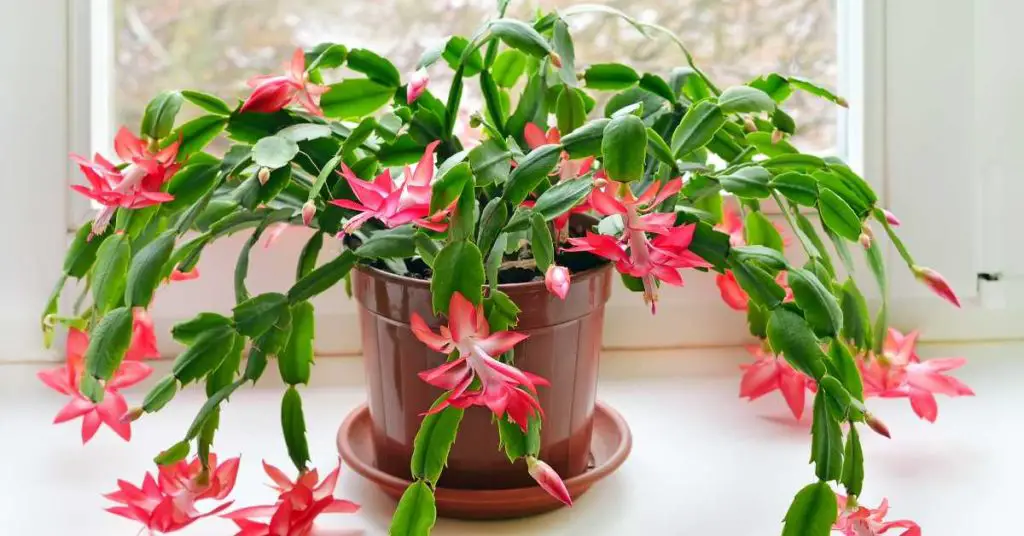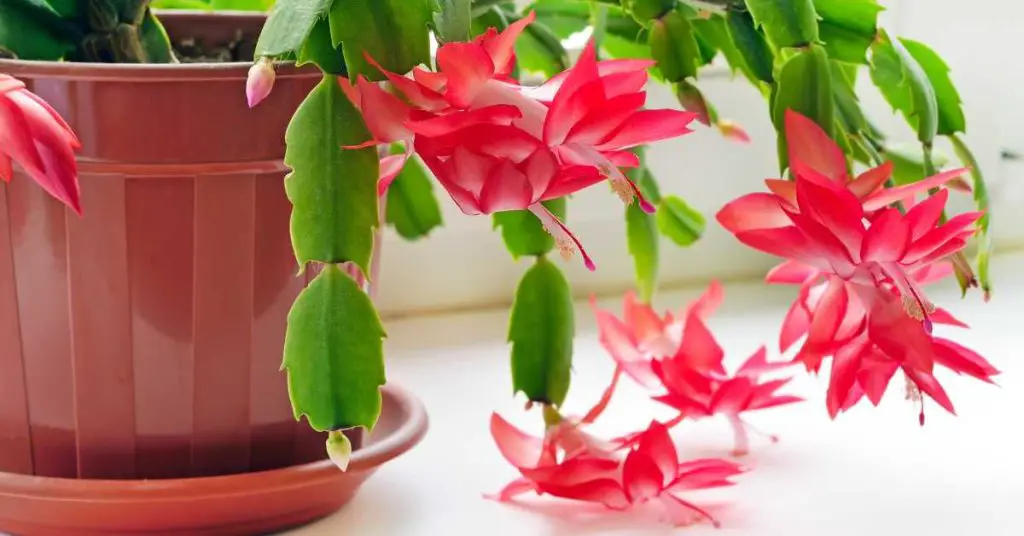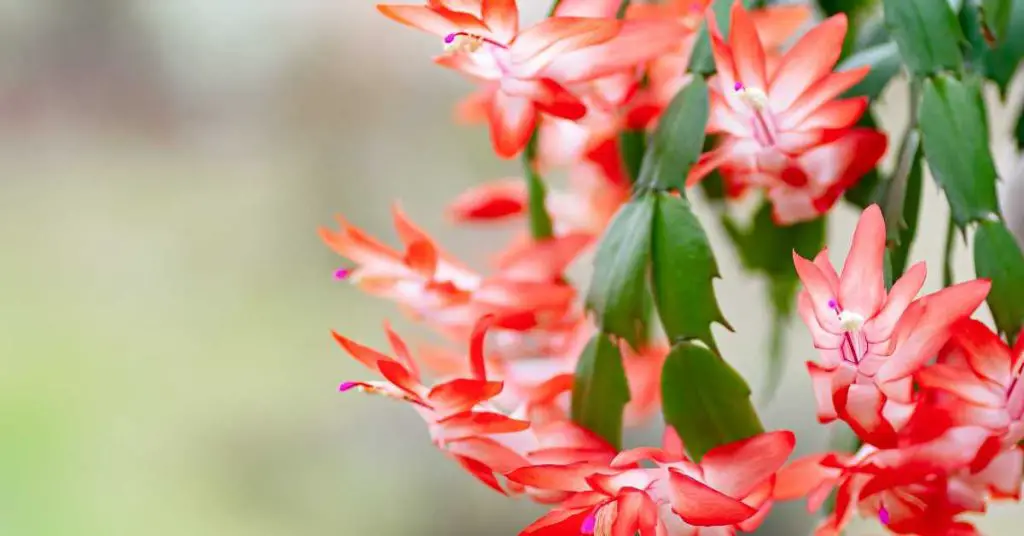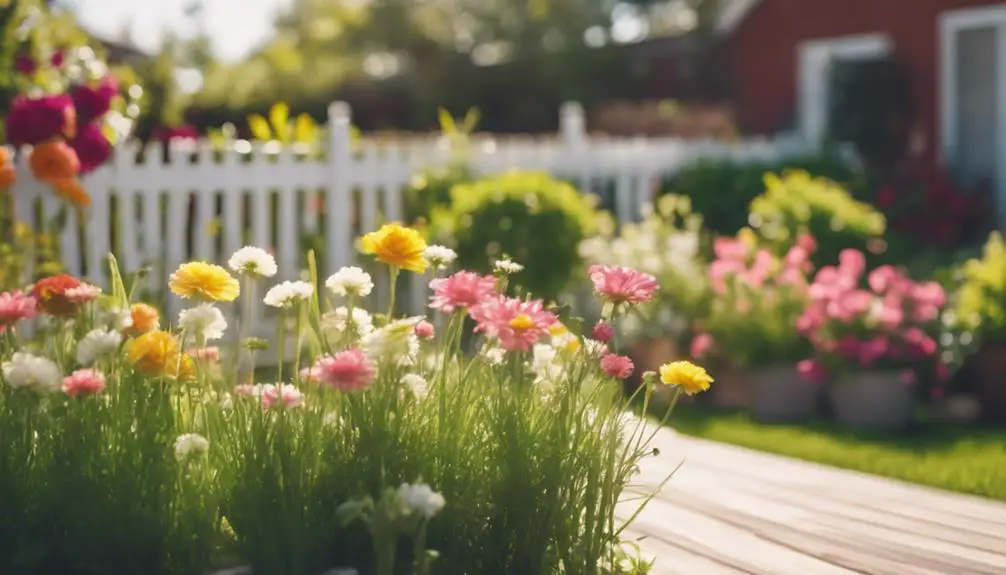If you’ve ever wanted to add a touch of festive color to your indoor space, growing a Christmas cactus is a rewarding experience.
From selecting the right location to mastering the art of propagation, there are several key steps to guarantee your plant thrives and blooms beautifully.
Understanding the intricate care requirements and anticipating the joy of watching delicate flowers emerge can truly elevate your indoor gardening game.
So, let’s begin this journey of nurturing and growing a Christmas cactus together.

Key Takeaways
- Place in bright, indirect sunlight to prevent leaf scorching.
- Water when the top inch of soil feels dry.
- Maintain temperatures between 60-70°F during the day.
- Prune to promote branching, cut just above leaf joint.
- Provide 12-14 hours of light per day, supplement with grow lights if needed.
Choosing the Right Location
To ensure your Christmas cactus thrives, place it in a spot with bright, indirect sunlight. Christmas cacti love natural lighting but avoid direct sunlight, as it can scorch their leaves. An east-facing window is essential, providing gentle morning sun. If an east-facing spot isn’t available, a west-facing window can also work well.
Temperature control is vital for your Christmas cactus. Aim for a consistent temperature between 60-70°F (15-21°C) during the day and slightly cooler at night. Avoid sudden temperature fluctuations and drafts, as they can stress the plant. Placing your cactus near heating vents or radiators should be avoided as well.
Selecting the Appropriate Container
When selecting a container for your Christmas cactus, keep in mind that the size matters – it should allow for the plant to grow comfortably.
Additionally, make sure the container has proper drainage holes to prevent waterlogging, which can harm the roots.
Choose a container that strikes a balance between aesthetics and functionality for the best results in growing your Christmas cactus.

Container Size Matters
Consider selecting a container that allows for ample root space and proper drainage when growing your Christmas cactus. The size of the container is essential for the well-being of your plant. Christmas cacti have shallow root systems, so a container that’s wider rather than deeper is ideal. This allows the roots to spread out comfortably. Additionally, a container with drainage holes at the bottom is vital to prevent waterlogging, which can lead to root rot.
When choosing a pot, opt for one that’s only slightly larger than the current root ball of your Christmas cactus. This helps maintain the right balance of soil moisture and prevents overwatering. Place the container in a location that receives bright, indirect light for most of the day. Avoid placing it in direct sunlight for extended periods as this can scorch the leaves.
Maintaining the proper container size ensures that your Christmas cactus thrives. By considering root space and drainage, you create an excellent environment for your plant to grow healthily.
Drainage Is Essential
Select a container with adequate drainage to ensure the health of your Christmas cactus. Proper drainage is essential to prevent waterlogged soil, which can lead to root rot and other issues. When choosing a pot for your Christmas cactus, opt for one that has drainage holes at the bottom. This will allow excess water to escape, preventing the roots from sitting in water and potentially rotting.
Consider the size of the pot in relation to the root system of your Christmas cactus. A pot that’s too large can hold excess water, increasing the risk of overwatering. On the other hand, a pot that’s too small may not provide enough space for the roots to grow and can lead to root-bound plants. Choose a container that’s just slightly larger than the current root ball of your Christmas cactus to allow for some growth but not too much excess soil that could retain water.
Maintaining the right pot size and ensuring proper drainage will help you control the watering frequency of your Christmas cactus, promoting a healthy and thriving plant.
Using the Correct Soil Mix
When caring for your Christmas cactus, using the right soil mix is essential. The composition of the soil should promote good drainage while retaining moisture.
Select a nutrient-rich mix that will support healthy growth and blooming of your Christmas cactus.
Soil Composition Tips
For your Christmas cactus to thrive, the correct soil mix is crucial for its growth and health. When selecting soil for your Christmas cactus, opt for a well-draining mix to prevent waterlogging, which can lead to root rot. A good mix consists of equal parts of peat moss, perlite, and sand. Peat moss retains moisture, while perlite and sand aid in drainage, striking a balance that promotes ideal root health.
To guarantee your Christmas cactus flourishes, consider the watering frequency and fertilizer application. Water your cactus when the top inch of soil feels dry, typically every 1-2 weeks. During the growing season in spring and summer, fertilize your cactus every 4-6 weeks with a balanced fertilizer diluted to half strength. Reduce fertilization during fall and winter when the plant is dormant.

Moisture Retention Importance
To ensure your Christmas cactus thrives, the appropriate soil mix is vital for maintaining ideal moisture retention and promoting healthy growth. When it comes to watering frequency, a well-draining soil mix is indispensable. Christmas cacti prefer slightly moist soil, so aim to water when the top inch of the soil feels dry to the touch. Overwatering can lead to root rot, while underwatering can cause stress to the plant.
Humidity levels also play a significant role in the health of your Christmas cactus. These plants thrive in moderate to high humidity environments. If you live in a drier climate, consider using a pebble tray filled with water placed near the plant to increase humidity levels. Additionally, misting the plant occasionally can also help.
Choosing a soil mix that retains moisture without becoming waterlogged is key. A blend of peat moss, perlite, and well-draining potting mix is often recommended. This mix allows for proper aeration while retaining enough moisture to keep your Christmas cactus happy and healthy.
Nutrient-Rich Mix Selection
Selecting a nutrient-rich soil mix is vital for the optimal growth of your Christmas cactus. To guarantee proper nutrient absorption, choose a well-draining soil blend specifically designed for cacti and succulents. Look for mixes that contain ingredients like peat moss, perlite, or sand to promote healthy root development and prevent waterlogging, which can result in root rot. These components help in moisture retention without compromising aeration, essential for cacti health.
When choosing a soil mix, consider the significance of fertilizer application. Christmas cacti benefit from a balanced, water-soluble fertilizer diluted to half-strength. During the growing season in spring and summer, apply this fertilizer every two to four weeks to support vigorous growth and vibrant blooms. However, reduce fertilization during fall and winter to allow the plant to rest.
Understanding Watering Needs
Understanding the watering needs of your Christmas cactus is essential for its health and growth. Proper hydration is key for maintaining the vibrant blooms and lush greenery of your plant.
Christmas cacti prefer slightly moist soil, so it’s important to water them thoroughly when the top inch of the soil feels dry to the touch. However, be cautious not to overwater, as this can lead to root rot.
As a general guideline, aim to water your Christmas cactus about once a week during the growing season in spring and summer, reducing the frequency to once every two to three weeks in the fall and winter when the plant is dormant.
Adjust your watering schedule based on the moisture levels in the soil rather than a strict timeline. By monitoring the soil moisture and adjusting your watering frequency accordingly, you’ll provide the best growing conditions for your Christmas cactus.
Providing Adequate Light
Maintaining the proper amount of light is essential for the healthy growth of your Christmas cactus. When it comes to light intensity, place your cactus in a bright location, but avoid direct sunlight as it can scorch the leaves. Indirect light from a south- or east-facing window is ideal. If you notice your plant becoming leggy, it might be an indicator of insufficient light. Consider supplementing with a grow light to provide the necessary intensity.
In terms of light duration, Christmas cacti thrive with about 12-14 hours of light per day. During the fall and winter, you can make sure they receive enough light by placing them near a lamp or turning on a grow light for the additional hours needed. However, during the spring and summer, make sure to protect your cactus from excessive direct sunlight to prevent burning.
Temperature and Humidity Requirements
To ensure excellent growth and blooming of your Christmas cactus, it’s crucial to provide the right temperature regulation and humidity control in its environment. Christmas cacti thrive in temperatures between 60-70°F (15-21°C) during the day and slightly cooler at night. Sudden temperature changes can cause bud drop, so try to maintain a consistent temperature for best growth.
When it comes to humidity, these plants prefer moderate to high levels. Aim for humidity levels around 50-60% to mimic their natural environment. You can increase humidity by misting the plant daily or placing a small humidifier nearby.
During the winter months when indoor heating dries the air, consider using a pebble tray filled with water beneath the plant to increase humidity. However, be cautious not to let the plant sit in water, as this can lead to root rot.

Fertilizing Your Christmas Cactus
When fertilizing your Christmas cactus, make sure you select a balanced, water-soluble fertilizer formulated for flowering houseplants. This type of fertilizer provides the essential nutrients your Christmas cactus needs to thrive and bloom beautifully. To support the best growth, apply the fertilizer every two to four weeks during the spring and summer when the plant is actively growing. During the fall and winter months, reduce the frequency to once a month.
The timing of fertilizer application is important to support the Christmas cactus’s growth cycle. By providing nutrients at the right times, you can help the plant develop strong, healthy stems and vibrant blooms. Additionally, choosing a water-soluble fertilizer enhances the nutrient absorption efficiency of the Christmas cactus. This means that the plant can more effectively take in and utilize the essential nutrients, promoting overall health and vitality.
Remember to follow the instructions on the fertilizer package for the correct dilution and application method to ensure the best results for your Christmas cactus.
Pruning for Optimal Growth
For ideal growth of your Christmas cactus, consider carefully pruning any leggy or overgrown stems to encourage new growth and a more compact, vibrant appearance. When pruning your Christmas cactus, use clean, sharp scissors or pruning shears to make precise cuts just above a leaf joint. This technique will promote branching and denser growth. Regularly removing any dead or damaged segments will also help the plant direct its energy towards healthy areas. By controlling the size of your cactus through pruning techniques, you can effectively regulate its growth and guarantee it remains a manageable size for your space.
Additionally, strategic pruning can enhance flowering and regulate the blooming cycle of your Christmas cactus. By removing some of the older segments, you stimulate the growth of new segments that are more likely to produce flowers. This process rejuvenates the plant, encouraging it to bloom more abundantly and consistently. Remember, proper pruning is key to maintaining the health and beauty of your Christmas cactus while promoting excellent growth and flowering.
Dealing With Pests and Diseases
Dealing effectively with pests and diseases is crucial for maintaining the health and vitality of your Christmas cactus. To keep pests at bay, inspect your plant regularly for signs of insects like spider mites or mealybugs. Prevent infestations by wiping the leaves with a damp cloth or spraying them with a mild soap solution. For a natural remedy, consider introducing beneficial insects like ladybugs that feed on common plant pests.
When it comes to disease management, make certain your Christmas cactus isn’t overwatered, as this can lead to root rot. If you notice any signs of disease such as discolored or wilting stems, act promptly to isolate the affected parts and adjust your watering routine. For more severe cases, seek professional advice from a local nursery or plant expert.
Propagating Your Christmas Cactus
Ready to expand your Christmas cactus collection?
Propagating your Christmas cactus is a rewarding process that involves taking stem cuttings to start new plants. Proper soil preparation is essential to guarantee the cuttings root successfully, and maintaining the right moisture levels through careful watering techniques will help your new plants thrive.
Get ready to enjoy more beautiful blooms by learning the art of propagating your Christmas cactus!
Stem Cuttings Method
To propagate your Christmas cactus using the stem cuttings method, you’ll need to select a healthy segment of the plant to encourage new growth. When choosing a segment, look for a piece that’s about 2-3 segments long. Using a clean, sharp knife, cut the segment right above a leaf node. This will be where the roots will emerge.
Propagation techniques for Christmas cacti involve allowing the cut end of the segment to callus over for a day or two. After this, you can dip the cut end into a rooting hormone. This hormone will stimulate root growth, increasing the likelihood of successful propagation. The benefits of using rooting hormone include faster root development and a higher success rate in establishing new plants.
Once your cutting is ready, plant it in a well-draining soil mix and keep it slightly moist. Place the cutting in indirect light and make sure it stays warm. With patience and care, your Christmas cactus cutting will soon develop roots and start growing into a beautiful new plant.
Soil Preparation Tips
For best propagation success when preparing the soil for your Christmas cactus, make sure you choose a well-draining mix rich in organic matter. Opt for a commercial cactus mix or create your own by combining potting soil with sand and perlite for improved drainage. The soil should be slightly acidic with a pH between 5.5 and 6.2 to mimic the cactus’s natural environment.
When it comes to watering frequency, allow the top inch of the soil to dry out between waterings. Stick your finger into the soil to check for dryness before watering. Overwatering can lead to root rot, so it’s essential to maintain a balance.
For fertilizer application, feed your Christmas cactus with a balanced, water-soluble fertilizer diluted to half strength. During the growing season in spring and summer, fertilize every 4-6 weeks. Reduce or stop fertilizing in fall and winter when the plant is dormant. Following these soil preparation tips will help your Christmas cactus thrive and grow beautifully.
Watering Techniques
When propagating your Christmas cactus, make sure that your watering techniques promote healthy growth and prevent issues like root rot. Watering frequency is important for the well-being of your Christmas cactus. During the growing season in spring and summer, water your cactus when the top inch of the soil feels dry to the touch. Make certain that excess water can drain out of the pot to prevent waterlogging. In winter, reduce watering to let the plant rest. It’s vital to find the right balance to avoid both overwatering and underwatering.
Monitoring soil moisture is key to successful watering. Use a well-draining potting mix to help maintain the right level of moisture. Feel the soil regularly to assess its dampness and adjust your watering routine accordingly. Remember, Christmas cacti are susceptible to root rot if they sit in soggy soil for too long. By paying attention to watering frequency and soil moisture, you can help your Christmas cactus thrive and flourish during its propagation journey.
Encouraging Blooms
Promote vibrant blooms on your Christmas cactus by ensuring it receives proper light and humidity levels. To encourage a healthy blooming schedule, place your cactus in a location with bright, indirect sunlight. Direct sunlight can cause the color of the flowers to fade. Keep the plant in a room where the temperature is consistent, avoiding drafts and sudden temperature changes.
Christmas cacti come in a variety of colors, including shades of pink, red, white, and even purple. To enhance flower color variations, consider adjusting the light exposure. If the plant isn’t blooming, it may need more darkness at night. Make sure it receives about 12-14 hours of darkness daily for a few weeks to encourage buds to form.
Maintaining proper humidity levels is important for healthy blooms. You can increase humidity by placing a tray filled with pebbles and water beneath the plant. As the water evaporates, it creates a more humid environment around the cactus. By paying attention to these factors, you can help your Christmas cactus produce beautiful and colorful blooms.
Handling Dormancy Periods
To successfully manage dormancy periods for your Christmas cactus, it’s important to understand the specific care requirements during this phase. Dormancy management is vital for the overall health and blooming of your plant. During winter, your Christmas cactus needs a rest period to prepare for its next blooming cycle. To provide adequate winter care, reduce watering frequency to about once a month, allowing the topsoil to dry out slightly between waterings. Additionally, place your cactus in a cooler location with temperatures around 50-55°F (10-13°C) to simulate its natural environment.
While in dormancy, limit fertilization to once every 6-8 weeks using a balanced houseplant fertilizer. Make sure your Christmas cactus receives bright, indirect light during this time, as darkness is essential for bud formation. Avoid moving the plant frequently and maintain a consistent environment to prevent stress. By following these dormancy management practices and providing proper winter care, you can ensure your Christmas cactus remains healthy and ready to bloom beautifully when the growing season returns.
Troubleshooting Common Issues
During troubleshooting common issues with your Christmas cactus, closely observe the plant’s physical characteristics and environmental conditions to identify and address any potential problems effectively.
To guarantee your Christmas cactus thrives, it’s essential to practice proper watering techniques. Overwatering can lead to root rot, while underwatering can cause wilting and shriveling. Find the right balance by allowing the soil to dry slightly between watering sessions.
Additionally, consider pest control measures to keep your plant healthy. Common pests like spider mites and mealybugs can infest Christmas cacti, affecting their growth. Regularly inspect the plant for any signs of pests, such as webbing or white cottony clusters, and treat them promptly with neem oil or insecticidal soap.
Frequently Asked Questions
How Do I Prevent My Christmas Cactus From Becoming Leggy?
To prevent your Christmas cactus from becoming leggy, consider pruning techniques to promote bushiness. Guarantee it receives adequate light to encourage compact growth. For propagation, use well-draining soil mix. Adjusting these factors can help maintain a healthy, full plant.
Can I Use Tap Water to Water My Christmas Cactus?
Yes, you can use tap water to water your Christmas cactus. Make sure proper drainage to avoid waterlogging. Water frequency depends on temperature and humidity levels. Monitor moisture to prevent overwatering. Keep your cactus happy!
Is It Normal for My Christmas Cactus to Drop Buds?
It’s typical for Christmas cacti to drop buds due to stress from sudden temperature changes or insufficient light. Guarantee proper watering techniques by keeping soil moist but not waterlogged. Adjust care to match the plant’s needs for healthy blooms.
How Often Should I Repot My Christmas Cactus?
When caring for your Christmas cactus, aim for an ideal frequency of repotting every 2-3 years. This helps guarantee root health and allows the plant to grow comfortably into a slightly larger pot.
Can I Place My Christmas Cactus Near a Drafty Window?
You should avoid placing your Christmas cactus near a drafty window as the fluctuating temperature can harm it. This plant thrives in stable conditions, so guarantee good air circulation without exposing it to drafts for best growth.
Conclusion
To wrap up, successfully growing a Christmas cactus requires attention to its specific needs for light, water, soil, and temperature. By providing the right conditions and care, you can enjoy a beautiful and blooming plant throughout the holiday season.
Remember to propagate, prune, and monitor for pests to guarantee the health and longevity of your Christmas cactus.
With proper care, your Christmas cactus will thrive and bring joy for years to come. Happy gardening!




